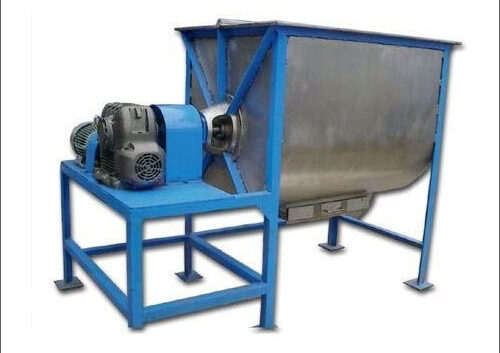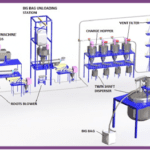RIBBON BLENDER
A ribbon blender, also known as a ribbon mixer, is a type of mixing equipment used for blending dry powders, granules, or other bulk solid materials. It consists of a trough-shaped container with a horizontal agitator, known as a ribbon, mounted on a central shaft. The ribbon typically has multiple layers and is shaped like a helix or spiral, allowing it to move materials in both radial and axial directions.
Ribbon blenders work by rotating a ribbon inside a mixing chamber. The ribbon is designed to create a convective flow of material, which helps to mix the materials evenly. The mixing speed and time can be adjusted to meet the specific requirements of the application.
Ribbon blenders are a versatile and efficient mixing solution for a variety of industries. They are used in the food, pharmaceutical, chemical, and other industries to mix a wide range of materials.

The key features and operation of a ribbon blender include:
Mixing Chamber: The mixing chamber, typically a U-shaped trough, provides the space for blending the materials. It can be constructed from various materials, such as stainless steel or carbon steel, depending on the application requirements.
Ribbon Agitator: The ribbon agitator is mounted on a central shaft and rotates within the mixing chamber. The ribbon design promotes efficient mixing by lifting and folding the material, creating a fluidized blending action. The ribbon may have different configurations, such as single or double ribbons, depending on the desired mixing efficiency.
Loading and Discharge: Ribbon blenders usually have a top-loading opening for adding materials and a discharge port at the bottom for emptying the blended mixture. Some models may also have additional openings for ingredient additions or sampling.
Mixing Time and Intensity: The blending time and intensity can be adjusted by varying the rotational speed of the ribbon agitator. Longer mixing times or higher rotational speeds generally result in more thorough blending, ensuring homogeneity of the mixture.
Options for Customization: Ribbon blenders can be customized with additional features to suit specific applications. These may include jacketed troughs for heating or cooling, spray nozzles for liquid additions, and safety features such as interlocks and covers.
Ribbon blenders are widely used in industries such as food processing, pharmaceuticals, chemicals, and plastics, among others. They are suitable for a wide range of applications, including blending dry powders, mixing granules, homogenizing different ingredients, and creating consistent mixtures for downstream processing.
It is important to select the appropriate size and configuration of a ribbon blender based on factors such as desired batch size, material properties, required mixing intensity, and the specific needs of the application. Consulting with experienced engineers or equipment manufacturers is recommended to ensure the right equipment selection and optimize blending performance.
KEY BENIFITS
- Versatile
- Gentle Mixing
- Cost-effective
- Efficient
- Durable
- Easy Maintenance and Cleaning

